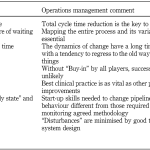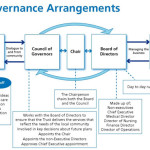It’s not been easy finding client assignments, notably NHS ones, but we all need money so yet again I’ve gone where the work is and will attempt to refill the coffers by spending a few months helping out Sherwood Forest NHS Trust. This is another troubled hospital Trust, though arguably the only ones that need to employ my skills are those in some difficulty and with skill gaps to be filled. In this case there is a remedial action plan which may or may not succeed. My role is to get to the root causes and find solutions the top 5 easy fixes (or whatever it happens to be) in order to hit the initial targets and to improve ongoing efficiency in order to prevent crippling fines.
This story is both very familiar and yet unique. While many of the performance issues occur UK-wide, every Trust has its own individual demography and incidence of different illnesses. One example came when I was working with Royal Berkshire Trust during a period of migration to the Reading area from Eastern European areas. Whether it was due to Catholicism or culture is not clear, but the incidence of births rose markedly, and had therefore to be planned by the Trust in order to prevent shortages of staff and facilities when the births were due.
Planning strategy and capacity ahead of times is the very least you would expect of competent management in any field, public or private, but in the Health Service such is the welter of expectations and current issues it is nigh on impossible for the boards of these Trusts to step outside firefighting mode and to do the jobs for which they were nominally employed: to provide long-term leadership and a 3-5 year strategic horizon which delivers success to the organisation and, especially, better, faster care and treatment to patients. In some cases plans may be developed piecemeal, such as finding capital funding to add a new extension, but rarely do you see Trusts following a consistent plan, better to serve the needs of the community.
A substantial part of the problem is that while continuous change is a component of any business plan, in this case the welter of change is relentless, most of it driven by government and much of it totally unnecessary. I could quote the Health & Social Care bill 2010 (for which the government had no mandate whatsoever), which changed the commissioning system at huge expense and no benefit whatever to patients, but this was only the latest, albeit the biggest, major change to the service.
In very few other sectors will you ever see the same requirement for endless reporting from so many different stakeholders. Financially the Trusts are measured on breaking even and having a surplus to support ongoing changes required by regulators and further improvements to patient service, yet they are also required to support services that will always be loss-making, yet in order to hit targets and avoid penalty clauses (many running to hundreds of thousands per month) being enacted most Trusts have no choice but to farm work out via private healthcare providers at their cost. In other words, financial instability is further penalised, making failure a self-fulfilling prophecy.
Nor can they ever cover the deficiencies of consultant contracts by paying piece work to add flexibility to their capacity management planning. In fact, there is barely a Trust in this country that does not have a shortage of skilled and specialist staff, met by employing locum doctors and bank nurses or Associated Healthcare Professionals, raiding qualified staff from other countries, and other tactics – though applying supply and demand and paying more to those with scarce skills is not an option under current rules. This particular dyke is perpetually springing leaks and very few if any Trusts have sufficient fingers to plug the holes.
In terms of other targets, and bearing in mind financial and staff shortages, there will be inevitable failures. Management teams are often reticent to take the steps necessary to admit failure and develop a recovery plan over time, since that would lead to penalties being applied and a constant battle to adjust and validate figures to look like they are winning battles that have long been lost.
Taking one area I know very well, 18 Week RTT targets, whereby each specialty treating elective patients is measured for admitted and non-admitted pathways, for which targets are set that respectively 90 and 95% of patients will be treated within 18 weeks from referral to treatment. The allowance is to cover cases of clinical complexity and patient choice. Since patients only have clock stops under RTT rules when they are provided with the First Definitive Treatment, the temptation is that those patients are deferred as long as possible to ensure patients who can be treated within 18 weeks get top priority, thus keeping performance figures remain high.
Typically this means Trusts have developed a backlog of patients requiring treatment and are therefore delaying the inevitable by rationing a small number through the system in every week. In the worst cases, a specialty with staff issues can build up a sizeable backlog, which will be visible to commissioners upon return of data on a monthly basis – and some Trusts have built up backlogs with sizeable numbers of patients over 52 weeks, the absolute maximum permissible, though a good many of those will appear due to glitches in data quality.
Ideally patients should always be treated in chronological order, subject to choice and complexity, but the system incentivises gaming, however much the Department of Health deplores the idea. That is the point of bad targets – they have unforeseen consequences, and are certainly not helped by inaccuracies caused by data quality breaches and coding mistakes on the PAS systems caused by bugs in the software, inadequate staff training or wrong coding decisions taken by data entry clerks. This why in many hospitals you will find staff at all levels engaged in data cleansing exercises at various times to “validate off” patients whose clocks should have been stopped. Validation is a hugely wasteful use of staff time, but until hospitals can be sure that data entry is “right first time, every time” there is little choice.
Another factor is the rate at which patients DNA – fail to turn up for appointments. They can be reminded by phone, text, email and any other method but sometimes something will happen: the patient may well not feel well enough to attend, they may not have a lift, the bus might be cancelled, the weather might be inclement, they might forget (particularly elderly patients), or they might just decide they can’t be arsed to get to the hospital. Whatever the reason, hospitals nationally have a typical DNA rate of 7%, which is a criminal waste of staff time, measured as opportunity cost.
More distortions come thanks to the demands of emergency admissions, of which mine this year was but one example. Sometimes, especially in post-Christmas consultant leave period, emergencies result in the mass cancellation of elective procedures and add greatly to the backlog. According to the rules these patients have to be contacted and options for treatment offered within 28 days of the cancellation, if you can get hold of the patients and if they are willing to accept any of the options on offer – and many will still prefer to be treated at their local hospital rather than accept treatment quicker at a hospital miles away, such that their loved ones may find it difficult to visit.
When you bear in mind that this discussion simply relates to elective patients on RTT pathways, omitting many more patients on a range of other pathways (including cancers), you can see how incredible complex hospital management can be – and how many obstacles are placed in the way of Trusts trying to do the right thing but getting clobbered for their efforts in many ways. Some do do a bad job and foster the wrong culture – as witnessed by the Mid Staffordshire crisis, for example – but many more competent management teams have suffered financial crises and boards being removed by choosing to put the needs of patients first, above hitting financial targets – which is what the public would urge the service to do. Others have been lambasted by MPs and local media for trying to close or merge some services in order to hit the targets foisted upon them, one such being when at a Trust I was working with a proposal to limit hours at the middle of three A&E units, each well within 10 miles of one another. Financially, it would have made sense to close one unit and ramp up services to the others, but an MP led a local campaign and forced the plan to be abandoned, in spite of a widespread consultation.
Something else you may also need to take into account is how contracts work in the new commissioning environment, bearing in mind that at the moment Trusts are paid by the volume of patients they treat, just as schools are paid by the number of students they teach. Doubtless at some point outcome measures will be applied, but do read on.
Traditionally, the optimum form of contract undertaken by PCTs and Acute Trusts was based on a block contract. That is, the PCT would undertake to send a planned number of patients with given range of conditions to that hospital, give or take a variable percentage. In each case the range of treatments and consultations undertaken would be coded by an expert team, then considered at contract review meetings. Complaints and issues would be dealt with at the meeting and overall volumes by procedure code against target would be reviewed and, if necessary, amended. The benefits of the system to both sides was that it gave the ability to plan within the confines of the contractual volumes and, with the assurance of a guaranteed income level, for the hospital to recruit the staff needed to conduct the contract requirements.
However, there is now a far greater pressure within the remit on the new-style CCGs to save money, and to do so by tendering contracts to private sector operators directly as well as micromanaging contracts with NHS hospitals. This means that long-term commitment to the local hospital is no longer guaranteed, and contracts are in many cases on PBR – payment by results. In itself this is not a problem if it is used wisely as a tool to provide value for money, but in practice it can prove almost impossible to manage: firstly because the sheer volumes of patient throughput makes review by case and verification of accuracy within coding and treatment very unwieldy; secondly, since it means hospitals have no assurance of income the management overhead and caution of decision making is all the greater. Losing income on which the Trust had depended can make the difference between success and failure, particularly when many had the albatross of PFI contracts thrust upon them at huge expense.
The effect of the reforms is to kill the public service ethos on which the NHS was founded. In short, it’s almost impossible for a hospital to win without being equally devious in expanding its profitable services and curtailing the services on which, at tariff, they cannot possibly make money – whatever public demand.
Given this inherent institutional short-termism, even jobs like keeping track of waste are formidably different, since the number of different consumables used within hospitals is truly staggering. Empowering staff is the key to success, but then supervising them to make sure they do jobs correctly can be a formidable task given high turnover and a serious shortfall in staff in middle and senior management ranks. This is not to excuse failures, far from it, but the sheer volumes managed require new and innovative solutions without the benefit of large-scale capital investment, and often with systems that fail to deliver.
Taking another example, there has been much talk in the light of Mid Staffs and other Trusts with high mortality rates of giving staff protection to act as whistleblowers and publicise bad or dangerous practice, plus guarantees that every single complaint is fully investigated. It almost goes without saying that what every Trust I’ve ever worked with tries to do is to establish a culture which encourages staff to report issues to senior management before they become a serious problem. Despite what you might read in the Daily Mail, I’m not aware of any Trust that deliberately suppresses such cases, and in almost all they are investigated and recommendations made for changes to clinical, administrative and/or management practice.
No doubt there are Trusts where such duplicity does indeed happen (Colchester has just been put in special measures for the alleged bullying of staff to falsify records), but I doubt very much if any cover up is solely to save the skins of the people concerned – there are so many regulators, inspectors and overseers that such bad practice could not be covered up. There is certainly a risk that sheer bandwidth is a problem and that staff simply do not have time to investigate every instance before it is escalated – in which case the solution is better systems and processes, and the time to ensure they are implemented effectively, which is where people like me fit into the equation.
Granted that some manage this incredible feat of juggling, and still plan ahead. They do so thanks to the incredible dedication of many underpaid NHS staff, the majority of whom regard their jobs as a vocation rather than a career. Whatever else you say about the NHS, and however much effort is put into improving processes and systems, it is still fundamentally a human business, just as patients are human and require very personal attention. And in many cases, freedom from government interference is the best chance Trust Boards have to do the jobs for which they were employed in the first place.










